333 years after the Japanese haiku master Matsuo Bashō, Mike Stevens follows his own narrow road, to the interior of Cornwall.
It is the Spring of 1689 and Matsuo Bashō, the Japanese haiku master, is planning a long pilgrimage from his home, over the mountains and into Oku, ‘the Interior’. His companion will be his friend, Sora, and together they have planned stops at wayside shrines as well as major temples to pay their respects, and, often, to spend the night there. Bashō will go on to record his journey in the classic travelogue, Narrow Road to the Interior. Written in ‘haibun’ form, combining short prose passages with 3-lined haiku poetry, this book was to become an important influence on Japanese poetry and, much later, on the Beat writers.
Old Bashō awakes
Rolls his thin sleeping mattress
Sits and meditatesCross legged on the floor
His travel gear patched and stowed
The road at the door.
Some 333 years later, at the end of September 2022, my brother, Craig, and I set out to walk a short part of the newly established 125-mile Cornish Celtic Way, carrying our sleeping bags and mats, having pre-booked our accommodation in a church, two village halls and a shepherd’s hut. The accommodation is made available by generous people all over Cornwall in the spirit of pilgrimage, costing only a token fee. The route and the accommodation list were provided when we bought our CCW passports, a beautifully produced book that cost only £6.
The increasing popularity of pilgrimage is reflected in the hundreds of thousands who walk the Camino in Spain each year, up from fewer than 1,000 in 1980. Like the Camino, the Cornish Celtic Way connects sites of spiritual and historical significance, going back 1,700 years or more. While the church sites are obviously Christian, the route is open to all.
Late September sun
winding down, but the robin
has plenty to do.
We caught an afternoon train on the St Ives to St Erth branch line, along the dune-fringed bay, and into what still looks like a Hornby model train station from the 1950s. The station takes its name from an Irish saint, Erc, a druid converted to Christianity by St Patrick. According to tradition, this branch line also connects sites associated with two of Erc’s siblings: his sister, the martyred St Ia of St Ives, as well as his brother, St Uny of Lelant. Today, St Erth is where you change trains.
The morning was clear.
Come afternoon, cloudy grey,
thickening for rain.
For Bashō, however, the morning of 16th May 1689 begins with sunshine, Mt Fuji shimmering in the early mist rising from the fields. Ahead lies the formidable Shirakawa Barrier and the unvisited mountainous interior. Pilgrimage has always involved crossing external and interior landscapes.
Heartlands of Honshu!
Shirakawa Barrier!
The road there is you!
The narrow road within,
Oku-no-hosomichi,
Where all paths begin.
For us there was only an easy train ride to St German’s and a meeting with Richard at the Priory. This was to be our first night’s accommodation. I had been in the Priory at St German’s before, watching live music there at the much-missed Port Eliot Festival, but I never imagined I would ever sleep there. Richard gave us a tour of the church, telling us about its history, its architecture, and its numberless dead interred under the floor where we would be sleeping.
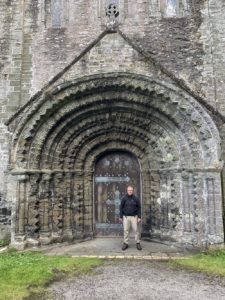
The church site itself goes back to the days of Celtic Christianity, a branch of the early church that had retained belief in the original goodness of creation. With the doctrine of ‘original sin’ gaining ground in the Western Church, in 429 a formidable French bishop, Germanus, was dispatched by the Pope to put an end to the Celtic way of seeing the world. The Priory is named after him.
Richard stamped our passports. The stamp is beautiful: the Priory circled by 3 choughs and the flag of St Piran, the patron saint of Kernow (Cornwall), flying from the bell tower. When we had arrived at the church earlier, however, I noted it was the red cross of England and St George that was flying there. We made our camp on a raised, carpeted area surrounded by children’s toys. It looked like the least haunted area.
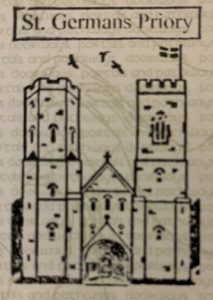
We did not sleep a wink. Not from fear, but from discomfort, excitement and the passage of time. We counted every strike of the bells chiming the hours through the night. But we saw no ghosts.
The wide-eyed pilgrims
counting the hours until dawn.
Where is their road now?
The morning of September 27, 2022 was bright, but the weather app promised rain later. The William Morris east window was growing ever more jewel-like as we sat drinking tea, but we had to make a start. We unbolted the massive wooden main door and stepped through its dramatic, stone-carved, Norman arch. We were proper pilgrims this time. On the road. We had a map from the excellent CCW handbook, and we headed for the coast: Downderry, Seaton and ultimately to Treargle Retreat, Portlooe. It was hilly. Whenever we were unsure of our direction, it was always up. And the weather app kept its promise.
For breakfast, we ate late blackberries from the narrow hedgerows still thick with fruit in places, and we were thankful to the people who had left bags of apples and tomatoes from their gardens to take for free. We had an early lunch in Seaton, where the friendly waitress called us ‘my ansums’. Then we went on to Looe. By now, it was raining hard.
Fishing boats listing
in the low tide mud.
Locals half-fill the cafes.
We spent that night in a lovely shepherd’s hut. Naomi, the owner, gave us a loaf of homemade bread warm from oven, and a pot of delicious, homemade yogurt. It rained all night, but we were showered, warm and dry, and lying on a proper mattress. The horses in the barn next to us were a gentle, heavy presence.
Hearing the rain fall,
the dense movement of horses,
almost medieval.
September 28 started fine and got finer, and we headed towards Polruan where we were to spend the night in the WI Hall. We took the coast path, then headed inland to find Talland Church. The sudden revelation of its bell tower rising out of a green hill was a delight. Here we got our second stamp.
Deep into his pilgrimage, Bashō will go on to describe a hellish section through places with ominous names: Children-Desert-Parents, Lost Children, Send-Back-the-Dog. We were walking through places full of meaning too, but we couldn’t understand them. Talland Church, for example, is not named after some fictitious fifteenth-century saint, Sanctus Tallanus, but is an ancient name in Kernewek, the Celtic language related to Welsh and Breton. The name of the church describes itself: tal (brow of a hill) + lan (church site). That is still what it looks like today: a church on the brow of a hill.
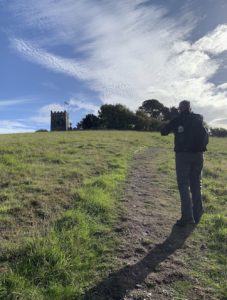
The loss of Kernewek has stripped the landscape of meaning for most people. I say ‘loss’, but it was not a language that was misplaced somehow. The reality of how it was lost is better captured in the phrase, ‘all hands were lost’, when a ship has been torpedoed. Kernewek and Cornish identity were deliberately and, often, violently suppressed. The landscape now seems on the other side of a great historical and linguistic gulf from us, still speaking, but we can’t hear it.
Den heb tavas a
Gollas y dir. Lose your tongue,
Then you’ve lost your land.
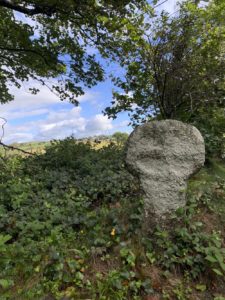
Polperro is probably what most people imagine when they think of a Cornish coastal town: old houses huddled around a granite harbour, good pubs, cafes, a Post Office. According to a recent Neighbourhood Development Plan for Polperro, 60% of the houses here are occupied by locals, 30% are holiday lets, 10% are second homes. A CornwallLive.com report somehow presented this as good news: a seaside town ‘bucking the trend’, where more houses are occupied than left empty for most of the year. The old Cornish name of the town is probably derived from Porth/Pol (harbour) + a proper noun (Pyre). Polpyre.
Another Cornish harbour town on fire.
We ate the last of Naomi’s home-baked bread there at the waterside looking out to sea. It was sunny and hot, and we talked about going for a swim. But it was getting late so we headed off uphill instead. We called by a few more churches to update our passports and at last we reached Polruan. We came along the river at Pont Pill and entered the town dropping down from the high woods, the water below us full of yachts and fishing boats.
On our way down the steep steps that lead to the harbour, we met a man coming up on crutches. He was dressed in woodland camo gear, but he was not an ex-serviceman, he told us. However, he was interested in history. He knew things about Hitler. He knew a Cornish accent when he heard one. He was a local, one of ten. We talked for a while, but my hips were aching, and I was ready for fish and chips and a beer. We were staying in the WI Hall at the top of a steep hill, where Sue, the WI Chair, told us we that had met Robert-in-the-Woods. For some reason, I didn’t ask the next obvious question: Does he live there?
It had started to rain a little. We went straight to ‘The Lugger’.
Eating like hungry
Sailors, the sea-window frames
A perfect rainbow.
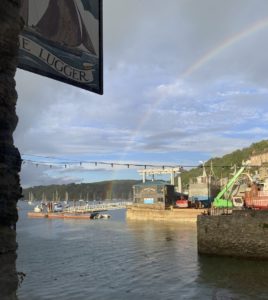
September 29 was our last day of walking the route, and it was to be our longest stretch. We crossed the River Fowey, The River of Beech Trees, in the busy water taxi that goes back and forth between the two towns separated by the wide estuary. The morning grew golden and warm. The Cornish Celtic Way joins The Saints’ Way at Fowey, first taking the coast path then cutting inland through tunnelled, quiet lanes and woodlands. Like Bashō, we were now heading north, into the interior.
The sea at our backs,
the road always leading up,
bound for the heartland.
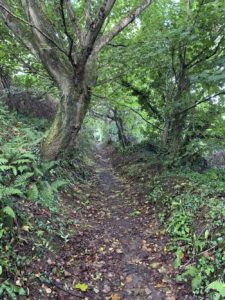
The CCW route is so well planned that, after a few hours of walking across open fields and down car-free lanes, it was a shock to enter the town of St Blazey and walk along its main road. At the level crossing, we were held up while dozens of wagons of china clay clanked their way down to the coast. Cornwall has the largest deposits of china clay in the world, and at least 50 years’ worth of reserves. But most of the extraction now takes place in Brazil.
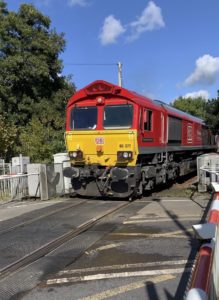
We ate sandwiches sitting in the sun outside St Blazey church, built in honour of St Blaise, an Armenian Bishop who was martyred by the Romans early in the fourth century. I was beginning to see a pattern to these places.
Look! back in shadowed
Lanes scattered with robin song
And ripening sloes.
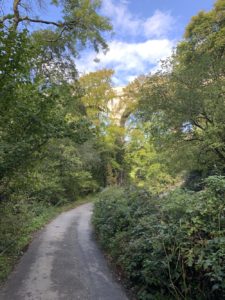
It was a long day’s walk, taking in the dramatic Treffry Viaduct and a holy well. Our destination was Gunwen (White Downs) Chapel on the edge of Bodmin Moor. This is the deep interior of Cornwall, equidistant from the holiday homes in Polperro and those in Padstow. Having been warned by Ivan, a local farmer and the chapel key holder, that there was ‘nothing here’, we ate in the pub at Luxulyan. After a good dinner, we hiked quickly over fields where the great granite bones of Kernow were coming through the earth, and hurried into the woods towards Lowertown before it got too dark.
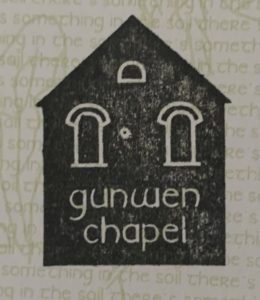
The chapel had been beautifully restored with a grant some years back, and we slept well in the hall below it. Up early the next morning, we set off for Lostwithiel into a beautiful sunrise. We got there just as the forecast rain started, had breakfast, and caught the train back to St Ives, retracing our steps to the door.
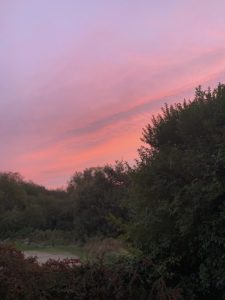
On the internet, you will find many companies offering guided walks that retrace the route of Bashō’s Japanese pilgrimage. They sound good. Perhaps one day we will go on one. But first we need to finish our own journey a little closer to home.
Ah well! so be it!
Mount Fuji in the distance
Shimmers in the mist.Today will be fine
Pink blossomed cherry trees, Spring
Sixteen Eighty-NineThe road there to roam.
Every day is a journey
And the journey is home.
*
All haiku by Mike Stevens.